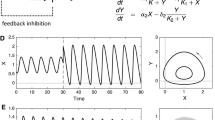Abstract
During a clock reaction an initial induction period is observed before a significant change in concentration of one of the chemical species occurs. In this study we develop the results of Billingham and Needham (1993) who studied a particular class of inhibited autocatalytic clock reactions. We obtain modified expressions for the length of the induction period and show that characteristic clock reaction behaviour is only observed within certain parameter limits.
Similar content being viewed by others
References
J. Billingham and P.V. Coveney, Simple chemical clock reactions – Application to cement hydration, J. Chem. Soc. Faraday Trans. 89 (1993) 3021–3028.
J. Billingham and D.J. Needham, Mathematical-modeling of chemical clock reactions I. Induction, inhibition and the iodate arsenous-acid reaction, Proc. Roy. Soc. London Ser. A 340 (1992) 569–591.
J. Billingham and D.J. Needham, Mathematical-modeling of chemical clock reactions II. A class of autocatalytic clock reaction schemes, J. Engrg. Math. 27 (1993) 113–145.
G.W. Burnet and H.W. Melville, Determination of velocity coefficients for polymerisation processes, Proc. Roy. Soc. London Ser. A 189 (1947) 456–480.
D.O. Cooke, Inorganic Reaction Mechanisms (The Chemical Society, London, 1979).
R.J. Field and R.M. Noyes, Oscillations in chemical systems, IV. Limit cycle behaviour in a model of a real chemical reaction, J. Chem. Phys. 60 (1974) 1877–1884.
P. Jones, J.E. Frew and N. Scowen, Inorganic fireflies – A chemiluminescent clock reaction, J. Chem. Education 64 (1987) 70–71.
P. Jones, M.L. Haggett and J.L. Longridge, The hydration of carbon dioxide – A double clock experiment, J. Chem. Education 41 (1964) 610–612.
P. Jones and K.B. Oldham, The theory of the formaldehyde clock reaction, J. Chem. Education 40 (1963) 366–368.
J.L. Lambert and G.T. Fina, Iodine clock reaction-mechanisms, J. Chem. Education 61 (1984) 1037–1038.
J.H. Merkin, A.J. Poole, J.D.B. Smith and B.W. Thompson, Analysis of the bromate-ferroin clock reaction, J. Math. Chem. 19 (1996) 15–32.
S.J. Preece, Mathematical modelling of chemical clock reactions and cement hydration, University of Birmingham, Ph.D. thesis (1999).
K.W. Watkins and R. Distefano, The arsenic(iii) sulfide clock reaction, J. Chem. Education 64 (1987) 255–257.
Author information
Authors and Affiliations
Rights and permissions
About this article
Cite this article
Preece, S., Billingham, J. & King, A. Chemical clock reactions: The effect of precursor consumption. Journal of Mathematical Chemistry 26, 47–73 (1999). https://doi.org/10.1023/A:1019121525203
Issue Date:
DOI: https://doi.org/10.1023/A:1019121525203




